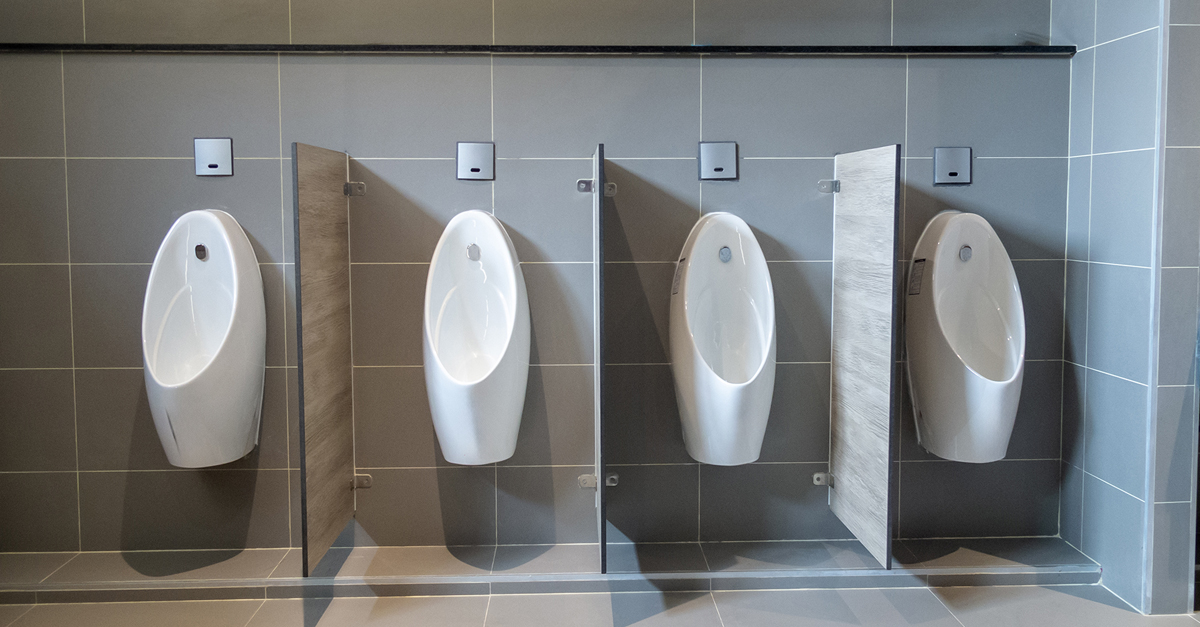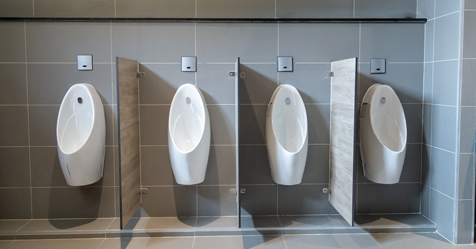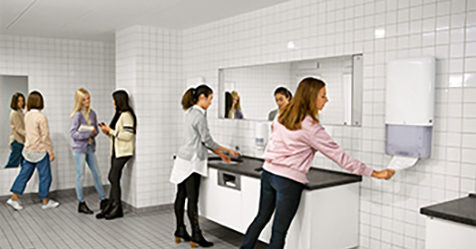Urinals, in one form or another, have been around for centuries. The basic design of urinals, as we recognize them today, was patented on March 27, 1866, by Dr. Andrew Rankin, who earned a degree in the field then known as Urineology from the University of Boston.
We can confidently assume that ever since then, urinal splashback has been a persistent concern.
Common causes of splashback
Splashback commonly occurs when urine hits the water stored at the base of a conventional urinal or strikes its sides. The resulting droplets can then become airborne, creating unsanitary conditions in public restrooms, potentially spreading germs. This not only increases the risk of disease, it also adds to custodial workloads and facility cleaning costs.
Unfortunately, some people downplay the health risks of urinal splashback by arguing that urine is a sterile substance. However, this is not entirely true. While urine is sterile when it is produced in the kidneys, it can become contaminated with bacteria as it passes through the urethra and exits the body, especially if the individual is ill.
Making matters worse, when the splashback lands on surrounding surfaces, such as walls, floors, and the urinal itself, it attracts soil and dirt, creating a breeding ground for harmful bacteria.
Experts suggest that one of the leading causes of splashback is the traditional design of urinals. Their slope and angle are not optimized to minimize splashing. Instead, these features exacerbate the problem. Additionally, the user’s height and stream strength play a role, especially when urine is directed toward the water at the bottom of the urinal, as is often the case.
Reducing splashback
While the traditional design of urinals is likely here to stay, there are several steps that users and facility managers can take to mitigate splashback:
- When using a urinal, direct your stream upward from the base of the urinal, so it does not splash into the water.
- Maintain a distance of six inches from the urinal to keep splashback away from clothing.
- Aim at a 45-degree angle, not a 90-degree angle.
- Select an end urinal instead of one in the middle. This reduces the chance of being splashed by someone using a neighboring urinal.
- When selecting a new urinal for your facility, look for one with a raised design at the bottom. This will help prevent urine from landing directly on the floor.
- Understand urinal types. Siphon jet urinals release a powerful stream of water to flush the urinal. Washdown urinals release a gentler stream, helping to reduce splashback.
- Consider waterless urinals, which do not store water at the base of the urinal. This feature can help minimize or even eliminate splashback.
- Install partitions around urinals to help confine the splashback.
- Use urinal blocks with caution. While the blocks can help fight odor, users tend to aim for the urinal block, which is a key cause of splashback.
Removing splashback
Removing urine splashback is not a simple task, but it is a crucial one. It requires cleaning professionals to be meticulous and thorough, as splashback can cover not only the urinal, but also the surrounding surfaces. Follow these steps when removing splashback:
- Wear gloves. Gloves are essential, and wearing goggles is also highly recommended.
- Use the right cleaning solution. If odor is present, it suggests bacterial growth. Apply disinfectant both inside the urinal and on all surrounding surfaces. If there is no odor, a sanitizer may be sufficient. In either case, follow the product instructions for contact time to achieve maximum effectiveness.
- Clean the flush handles. Also apply the cleaning products to the flush handles. Handles are high-touch surfaces where germs can easily spread.
- Use microfiber cloths. Cleaning requires a top-to-bottom approach using a clean microfiber cloth. Be sure to change cloths frequently. Clean the metal surfaces first, then the surrounding areas, including the walls and partitions.
- Clean the interior. For waterless urinals, wipe the interior clean. In conventional urinals, mineral deposits can accumulate due to the presence of hard water. These mineral deposits can also mix with uric scale, increasing the risk of blockages. In such cases, use a toilet bowl brush and a powdered cleaner to gently scrub the interior of the urinal.
- Flush without direct hand contact. Always flush a conventional urinal after cleaning, but do not use your gloved hands to do so. Instead, use your fist, forearm, or elbow to punch or push the flush handle. This prevents the transfer of germs and bacteria from your gloves to the flush handle.
- Wipe the sides and bottom. Wipe clean the sides of the urinal, but don’t overlook the area underneath; this is where splatter can collect, leading to an unsightly surface that accumulates soil and becomes the source of restroom odors.
- Mop the floor. Always apply a disinfectant or sanitizer on the floor surrounding the urinal before mopping. Then, mop as usual, paying extra attention to grout areas, which often collect urinal backsplash.
Keeping it clean
Urinal splashback issues have been with us for decades. However, it was during the pandemic that health officials realized how the issue can affect public health.
By following the steps outlined above, you can help reduce splashback and support the health of both restroom users and custodial staff. A clean and safe restroom is not just a matter of comfort; it’s also a crucial aspect of maintaining public health.




